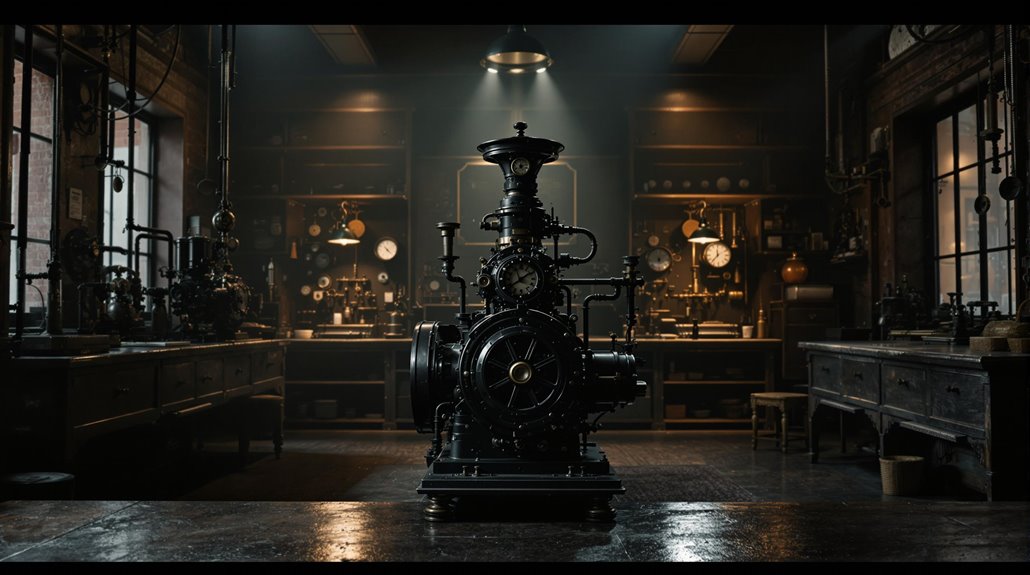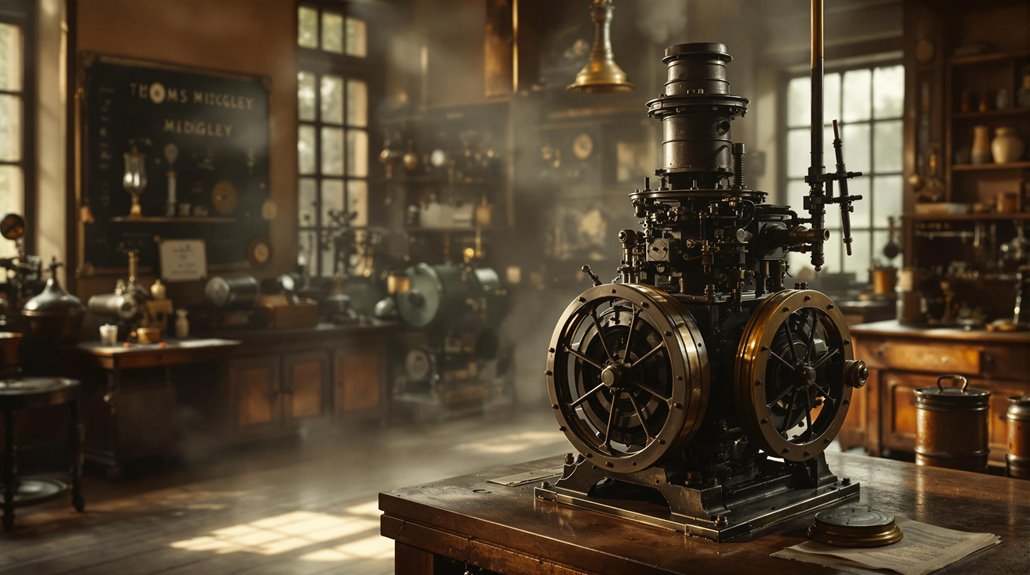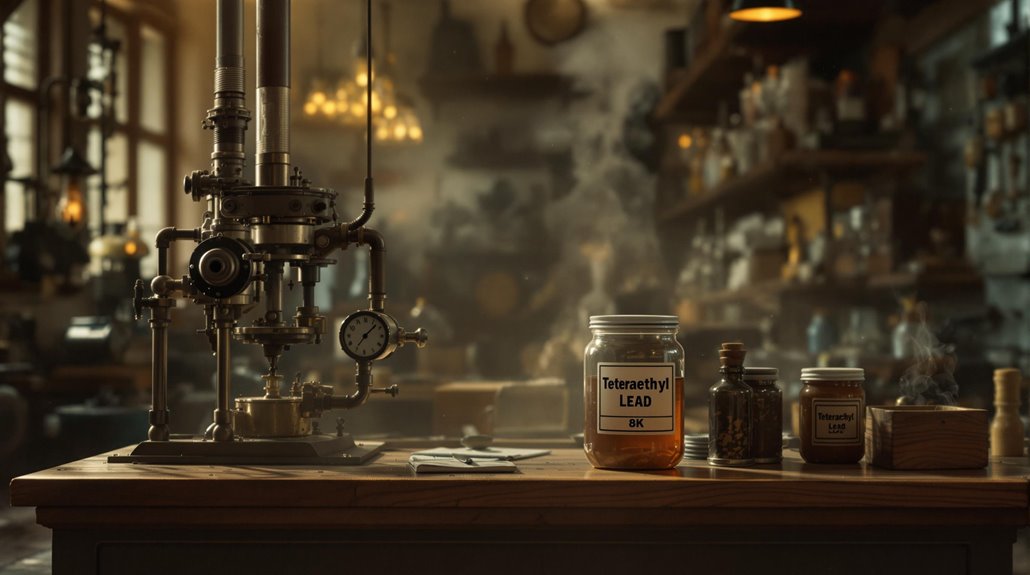Thomas Midgley Jr.: The Man Who Fixed Engines—and Broke the Ozone Layer
You've probably never heard of the scientist who unintentionally left quite a mark on our planet. Thomas Midgley Jr. wasn't just another inventor tinkering in his workshop—he created solutions that changed the automotive and refrigeration industries forever. While his innovations made cars run smoother and kept food fresher, they also released unprecedented environmental challenges we're still tackling today. His story reveals how even the brightest minds can't always see the full scope of their scientific achievements.
The Early Years: From Pennsylvania to General Motors

Inventiveness ran in Thomas Midgley Jr.'s blood. Born in 1889 to an inventor father and the granddaughter of a renowned toolmaker, you can trace his childhood influences to a family legacy of innovation.
After moving from Pennsylvania to New Jersey, and finally settling in Columbus, Ohio, young Midgley's path to becoming an engineer began taking shape.
His academic achievements started at Betts Academy, where a chemistry teacher sparked his lifelong fascination with the periodic table. This fascination would later help him secure over a hundred patents throughout his career.
After excelling in both sports and studies, he earned his mechanical engineering degree from Cornell in 1911. He soon married Carrie Reynolds, beginning his personal and professional journey.
His early career moves reflected his versatility – from working as a draftsman at National Cash Register to joining his father's tire factory.
The Quest to Stop Engine Knocking
While early automobile engines showed great promise, they suffered from a persistent and damaging problem: knock. This irregular combustion threatened engine performance and could wreck pistons, cylinder walls, and bearings if left unchecked.
Engines were especially vulnerable because using low octane fuel would cause severe detonation knocking.
In 1916, you'd find Thomas Midgley Jr. joining General Motors' research team with a clear mission: solve the knocking crisis. Working alongside Charles Kettering, he methodically tested various fuel additives. However, what started as a solution would later prove to be one of the most devastating environmental disasters.
Here's what made his quest remarkable:
- He tested over 100 different substances
- He used rigorous scientific trial and error methods
- He finally discovered tetraethyl lead (TEL) in 1921
This breakthrough transformed the automotive industry. TEL dramatically improved fuel efficiency and enabled more powerful engines.
After GM patented it in 1922, "Ethyl" became the standard gasoline additive worldwide, revolutionizing automotive design and performance.
Tetraethyl Lead: A Deadly Innovation
Midgley's triumph over engine knock came at a devastating cost. When he discovered tetraethyl lead (TEL) in 1921, he set free one of history's worst cases of industrial negligence. Despite knowing lead's extreme toxicity, GM and Standard Oil marketed TEL as "Ethyl" to mask its deadly nature.
You can trace the toxic legacy of Midgley's invention through decades of widespread devastation. Workers at TEL plants suffered severe lead poisoning, hallucinations, and death – including Midgley himself, who took leave to recover. The compound was produced by reacting chloroethane with a sodium-lead alloy, creating a deceptively sweet-smelling liquid. Though ethanol was available as a safe alternative, it wasn't patentable and thus ignored.
As leaded gasoline became ubiquitous, it released 7 million tons of lead into America's atmosphere alone, causing widespread brain damage and developmental disabilities. The WHO estimates hundreds of thousands still die annually from lead exposure, even though most countries banned TEL by the early 2000s.
The Freon Revolution in Refrigeration
After his work with tetraethyl lead, Midgley turned his attention to revolutionizing the refrigeration industry by developing Freon in the late 1920s.
Working with Frigidaire, General Motors, and DuPont, he created a refrigerant that would transform home cooling forever.
Freon quickly became the standard due to its low toxicity and reactivity, making it ideal for widespread commercial applications.
The impact of this refrigeration innovation was immediate and far-reaching.
Like his work with leaded gasoline, Midgley's invention of CFCs addressed immediate needs but had devastating environmental consequences.
Consider these remarkable achievements:
- Freon safety was publicly demonstrated by Midgley himself in 1930, proving it was non-toxic and non-flammable.
- By 1935, over 8 million refrigerators using R-12 had been sold.
- Annual sales peaked at over $1 billion, with production exceeding 1 million metric tonnes.
You wouldn't know until decades later that this miracle compound would severely damage Earth's ozone layer, leading to its eventual phase-out under the Montreal Protocol of 1987.
A Century of Environmental Impact

The lasting environmental devastation from Midgley's two major inventions wouldn't become clear until decades after his death. His innovations released 7 million tons of lead into America's atmosphere and damaged the ozone layer through CFC emissions.
You'll find lead's toxic legacy everywhere – in soil, plants, and even human bodies, causing widespread health issues and developmental disabilities. He experienced the dangers firsthand when he took a leave of absence due to lead poisoning. His work was initially celebrated despite known risks from lead toxicity.
While both inventions drove technological progress, their environmental impact has been staggering. Lead poisoning still contributes to hundreds of thousands of deaths annually, while ozone depletion continues to increase cancer risks worldwide.
Though CFCs were banned in 1994 and leaded gasoline has been largely phased out globally, the damage persists. Today, nations spend billions on environmental remediation efforts, making Midgley's story a sobering lesson in weighing innovation against long-term environmental consequences.
A Complex Scientific Legacy
Despite the environmental devastation his work later caused, Thomas Midgley Jr.'s scientific achievements paint a complex portrait of innovation and unintended consequences. His story raises critical questions about scientific ethics and industrial responsibility that we're still grappling with today. After being struck with polio, he continued his scientific work and leadership despite being confined to a wheelchair.
You can't deny his brilliant problem-solving abilities, which yielded:
- Over 100 patents in chemistry and engineering
- Revolutionary solutions like tetraethyl lead for engine knock
- Groundbreaking refrigeration technology with Freon
Yet these same innovations that earned him prestigious awards, including the Priestley Medal and Nichols Medal, later proved catastrophic for the environment. He died tragically when he became entangled in his pulley system, a mobility device he had invented to help himself get in and out of bed. Midgley's legacy serves as a stark reminder that scientific progress must be balanced with environmental stewardship. His story demonstrates how even the most celebrated achievements can have far-reaching, destructive consequences that weren't apparent at the time of discovery.











